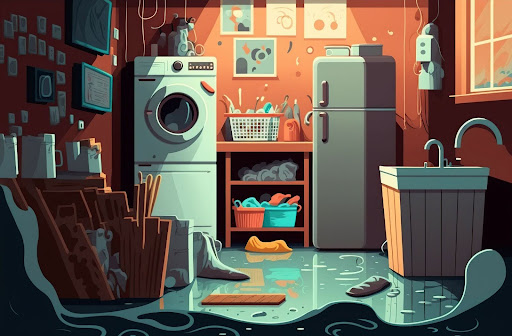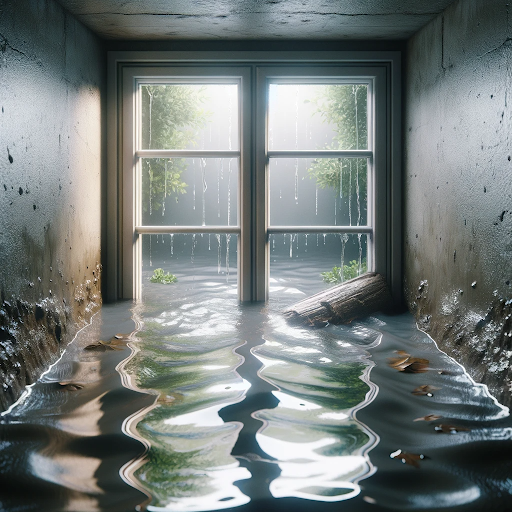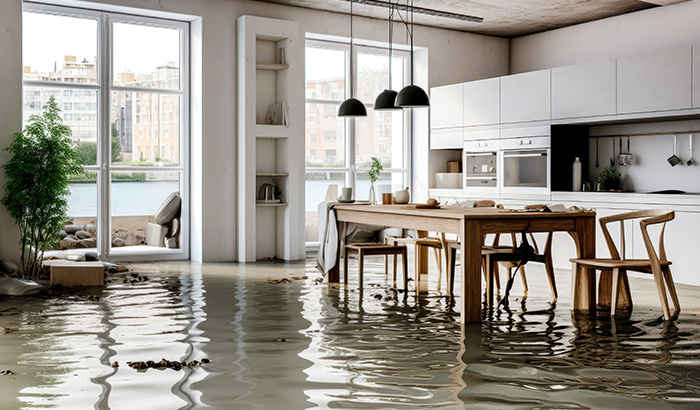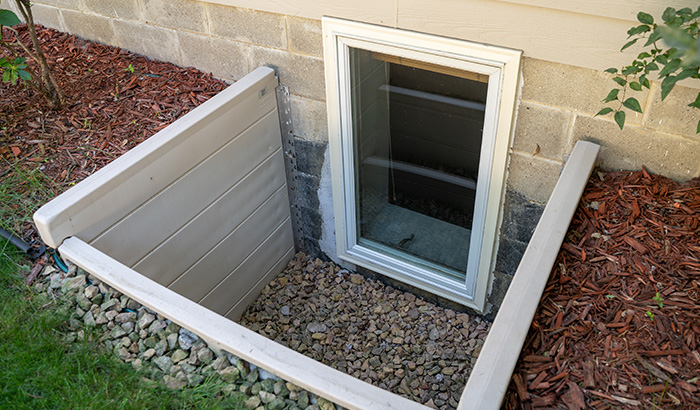Window wells are essential for letting light into your basement and providing a safe emergency exit. However, window wells sometimes become a catch basin for rainwater and melting snow, leading to potential flooding issues.
This guide will help you understand why window well flooding is problematic and how to address it effectively.
Why Worry About Window Well Flooding?
Window well flooding might seem like a small issue, but it can escalate into a homeowner’s nightmare. If water starts pooling in your window well, before you know it, this excess water seeps into your basement, damaging everything from your favorite carpet to essential structural elements like walls and floors.
And it doesn’t stop there. The water pressing against your home’s foundation quietly compromises its strength, potentially leading to costly structural repairs.
But perhaps the most pressing reason to keep an eye on window well flooding is the risk of mold. This unwelcome guest sneaks in, posing health risks and turning your safe haven into a hazard, especially for anyone with allergies or breathing issues.
Preventing window well flooding safeguards your home’s structure and your family’s health. A little attention to this detail saves you a lot of trouble down the road!

Early Detection: Spotting the Signs of Window Well Flooding
Being proactive about window well flooding is a smart move that protects you from a world of costly repairs and headaches. Start by regularly checking your window wells, especially after heavy rain or when snow starts to melt. Pooled water in or near these wells is a telltale sign that something’s not quite right.
It’s also a good idea to take a good look at your basement walls. Do you see any watermarks or damp spots? These are often subtle hints that water is making its way inside, possibly from overflowing window wells.
Peeling paint or visible mold around these areas is another giveaway that moisture intrudes where it shouldn’t be. These signs are not only unsightly but also indicate potential damage to your home’s interior.
And don’t underestimate the power of your nose in this detective work. A musty odor signals that dampness or mold might lurk in your basement’s shadows. This smell is often the first indicator of a problem, even before visual signs become apparent.
By keeping a watchful eye (and nose!) on these indicators, you’ll catch window well flooding early on. This proactive approach is key to maintaining a dry, healthy home environment, free from the worries of water damage and mold growth.
Understanding the Causes of Window Well Flooding
If you notice your window wells turn into mini pools after a rainstorm, you’ll want to investigate the usual suspects.
First, there’s your yard’s layout. If your garden slopes toward your house rather than away, it’s like rolling out a red carpet for water right into your window wells.
Next up, the window well drains. They’re meant to be escape routes for water, but when clogged with leaves or worn out, they’re more of a trap than an escape. And those basement windows? Small gaps or old seals secretly invite water in, especially when the weather gets wild.
Don’t forget about window well covers. They should be your window wells’ guardians against rain and debris. But if they’re damaged or missing, they’re more like an open invitation to water.
And speaking of weather, when Mother Nature throws a tantrum with heavy rains or quick snowmelts, even the best setups might struggle. That’s why keeping your gutters and downspouts clear is like having an umbrella for your house.
Understanding these factors helps you become a water detective, ready to spot and stop potential flooding before it starts.

Dealing with Flooding: Immediate Action Steps
When flooding strikes, time is of the essence. Quick action is the difference between a minor inconvenience and significant damage.
Here’s how to handle a flooding situation effectively:
Prioritize Safety
Before you do anything, make sure everyone is safe. If water is near electrical outlets or devices, turn off the power in the area. It’s always better to err on the side of caution, so if you’re unsure about safety, consider shutting off the power to that part of your home or consulting a professional.
Assess the Situation
Gauge the amount of water you’re dealing with. This will determine your course of action. For significant flooding, a sump pump is your best bet to remove large volumes of water quickly and efficiently. If the water level is more moderate, a wet vacuum is very effective. For smaller puddles, don’t underestimate the power of a good old-fashioned bucket and mop.
Remove the Water
Start the water removal process based on your assessment. The key here is to act swiftly but safely. The longer water sits, the more damage it causes.
Dry the Affected Area
Once you’ve removed the water, it’s time to focus on drying out the area thoroughly. This step is crucial to prevent mold and mildew growth. Use fans to circulate air and a dehumidifier to pull moisture from the environment. Open windows if the weather permits to aid in the drying process.
Clean and Disinfect
After drying the area, cleaning and disinfecting are vital to ensure no harmful bacteria or mold spores are left behind. Use appropriate cleaning agents and follow the label instructions for the best results. Pay special attention to carpets, walls, and any items that were in contact with the floodwater.
By following these steps, you effectively manage a flooding situation in your home, minimizing damage and maintaining a healthy living environment. Remember, the faster you act, the less damage you’ll have to deal with, and the quicker you get your home back to normal.
Preventing Future Flooding: Proactive Measures
Taking proactive steps to prevent window well flooding is a smart strategy for any homeowner.
Here are a few key measures to help keep your basement dry and flood-free:
Invest in Quality Window Well Covers
The right window well cover is a game-changer. Opt for covers that fit snugly over your window wells to effectively block rain and debris. This simple addition reduces the amount of water that accumulates in your wells.
Regular Window Maintenance
Your basement windows are more than just viewpoints; they’re crucial barriers against moisture. Inspect them regularly for any signs of wear and tear. Look for gaps, cracks, or old seals that might allow water to sneak in and address these issues promptly. A well-sealed window is a frontline defense against water intrusion.
Smart Landscaping
Believe it or not, your garden might be a powerful ally in water management. Plants that thrive in water, like certain grasses and flowers, are able to absorb excess moisture in the soil. Consider creating a rain garden — an area designed to catch and absorb runoff water —- in your yard. This solves water issues and adds to your garden’s beauty.
Gutter and Downspout Care
These are your home’s rain management superstars. Keep them clean and blockage-free to ensure they’re always ready to do their job. Make sure your downspouts are directing water away from your foundation. A downspout that spills water directly next to your foundation is an open invitation for water to find its way into your window wells.
Each step not only contributes to keeping your basement dry but also enhances your home’s overall health and aesthetics. A little effort in prevention saves a lot of work in repair, making your home a safer and more comfortable place to live.
Protect Your Home with Windowell Expressions
For those in Salt Lake City, Utah, Windowell Expressions offers top-notch solutions for window well concerns. From custom liners to durable covers, our products are designed to withstand weather challenges while improving your home’s look.
For more information or to request a quote, contact Windowell Expressions or call 801-683-0838 and take a step towards a safer, more stylish home.







